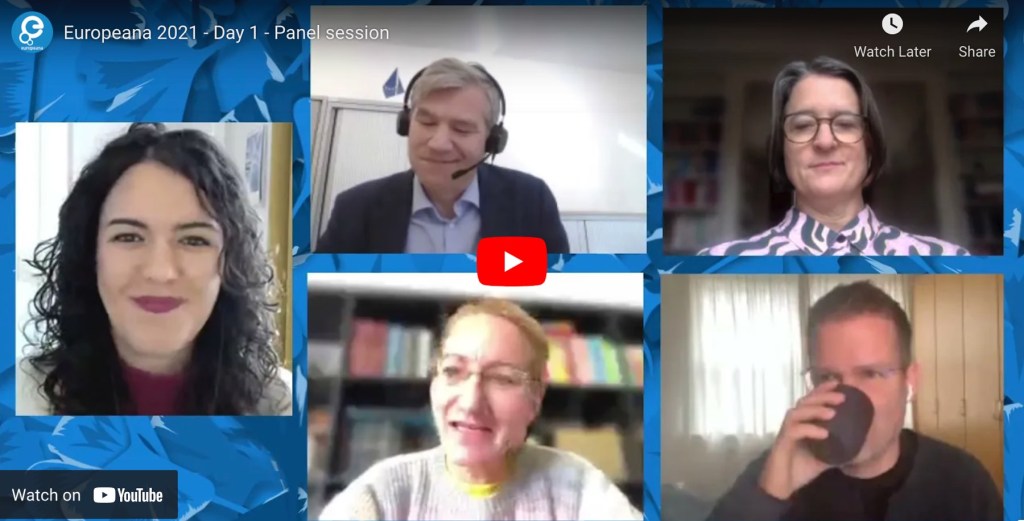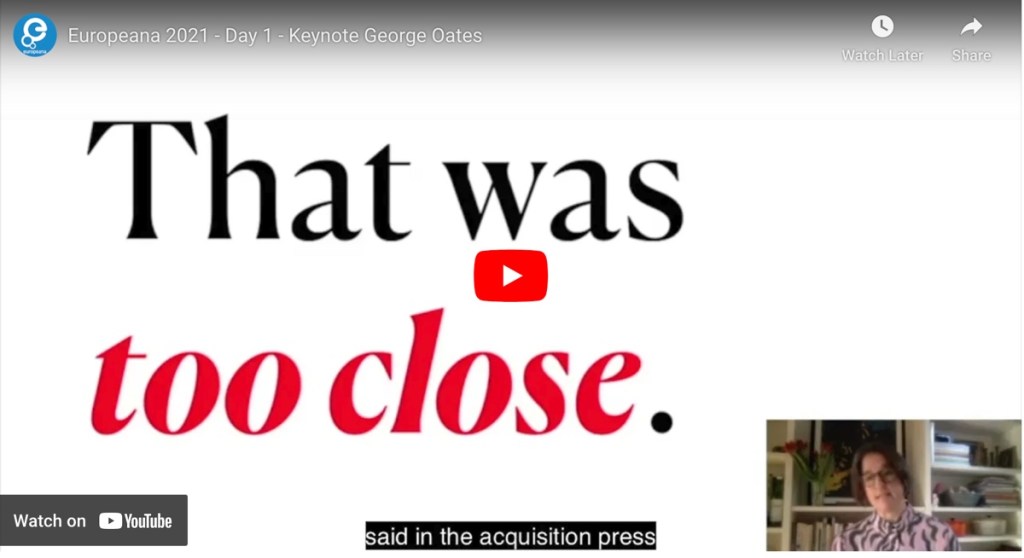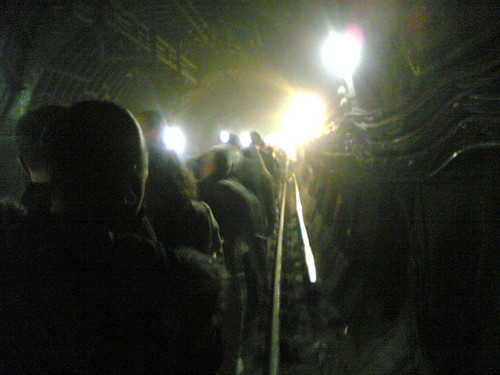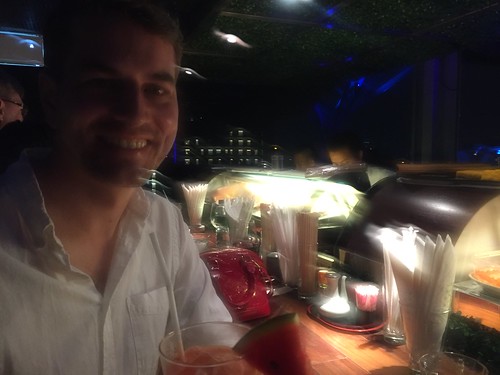Europeana 2021
10-12 Nov 2021Coming of age in the Digital Decade: A 17 year old software company and what it means to look ahead
In this keynote given at Europeana 2021, George Oates explores the case of Flickr, which launched back in 2004 and has now grown to an archive of tens of billions of images.
“we need to deliberate and determine how to steward the transition from business to public service to infrastructure, and make sure these gigantic and fast-growing collections of our contemporary cultural lives can’t be destroyed.”
- When will it be OK for public infrastructures to use private technologies?
- When should businesses underpin public services, with their limitations of liability?
- When should a business consciously become an infrastructure, and how does that change accountability?
Here’s the script:
SLIDE 1
Hello. Today I’m going to present for you “A 17 year old software company and what it means to look ahead.”
SLIDE 2
My name is George Oates. Thank you to Harry for inviting me to speak here today. I hope you enjoy this pre-recorded talk, and I’m looking forward to the panel coming up afterwards.
I’m a designer, and I’ve worked on web and hardware projects for 25 years.
SLIDE 3
I’m here today to talk about the idea of digital public space.
One of the biggest digital public spaces I’ve worked on is Flickr, the photo sharing service. It launched in February 2004, and it’s still alive. I was the lead designer from Day 1 to the end of 2008.
This is one of my very early pictures, taken in March 2004, of the Flickr office in Vancouver. We’d been to Ikea that day, where I chose the plants and lamps. You may notice this is about the 16 thousandth photo in the system.
SLIDE 4
People who were using the platform with us could see us building it. We were working very publicly and that was really fun. Deploying fresh code or new UIs a thousand times a day, and having conversations with folks using it, and becoming friends in many cases. We could see each other and that was good.
Anonymity on the platform was and still is suspicious, in fact.
SLIDE 5
In this 2005 TED talk called Institutions vs Collaboration, the American writer and teacher Clay Shirky observes the beginnings of a revolution caused by collaborative digital places like Flickr. The energy or cost it takes for a set of individuals to quickly do something cooperative in a system like Flickr is minuscule compared to how a traditional institution would prefer it be done.
Sixteen years ago, he suggested that things were going to be pretty chaotic for us, and he guessed it might be chaotic for about 50 years — compared to the 200 years of chaos that ensued once the printing press was up and running.
SLIDE 6
In 2007, I had the opportunity to create a program at Flickr called Flickr Commons, designed to increase access to publicly held photography collections, and to gather new information about them wherever possible. We launched in January 2008 with the Library of Congress as our first partner.
SLIDE 7
The day we launched, overnight, the community gathered a never-before-assembled collection of photos of women working around the USA, taken in 1939. They were gathered using the phrase “rosie the riveter” which is something the Library of Congress had never done.
This seems so normal now, this instant co-operation. But, back then, it was a wonderful surprise, and very interesting and tickling for the Library of Congress. They had come to Flickr to explore “Web 2.0”, brought their photographs to where the people are, and were curious and intrigued by what happened.
In hindsight, this program was a watershed for GLAMs around the world, because it was a positive force in allowing orgs to share materials they were pretty sure were OK to share, but where actual provenance wasn’t clear enough to use a legal license. We borrowed the Library of Congress’s assertion of “no known copyright restrictions” and made it available to any organisation that joined.
SLIDE 8
Today, the Library of Congress is still one of the most active partners in the Flickr Commons program, and they’ve enjoyed community contributions, relationships, and research that have resulted in over 15,000 official catalogue updates.
I’ll come back to the Shirky’s chaos later.
SLIDE 9
Today, this is the outline of the shape of Flickr Commons.
There are 114 member institutions from 24 countries, 7 million photographs, and around 30 organisations from the EU.
SLIDE 10
This is a graph of photos arranged by the date they were taken.
SLIDE 11
And you can see it drop off in 1921, 100 years ago.
SLIDE 12
I want to zoom out though, to the larger Flickr corpus, which has ballooned into a massive digital space with tens of billions of images in it and millions of users, from all around the world.
SLIDE 13
John Berger explains photographs as “observable moments”, a definition I like, especially in the Flickr context, because it gives you a sense of what it is. There are millions of photos taken all over the world every year since photography was invented to just a moment ago.
SLIDE 14
Like this observable moment, captured in a photograph called “Inside bombed tube train” taken in London on the 7th of July 2005 by Alex Chadwick
https://www.flickr.com/photos/alexanderchadwick/128895715/
SLIDE 15
Or “Evacuating through tube tunnel 2”
SLIDE 16
Or “Me covered in smoke and ash” as Alex got above ground on that terrible London day
https://www.flickr.com/photos/alexanderchadwick/128895718/
SLIDE 17
The good news is, here’s Alex 12 years later on his honeymoon, also on Flickr. Congratulations, Alex!
SLIDE 18
This digital public space has been shaped by use, over time. By agreement and cooperation and sharing and community.
50 billion images in 17 years!
SLIDE 19
We have these different gradients too, in terms of licensing and reusability of those images. This chart shows you the different kinds of licensed material within the collection.
There are only — only — 7 million or so images in Flickr Commons today; more Creative-Commons licensed images, but the vast majority isn’t openly licensed.
SLIDE 20
But, using our historical Flickr Commons collection as a prompt, most of that photography is over 100 years old now, and largely in the public domain.
So, if we look at our 50 billion images, and then look ahead 100 years, could we suppose those 50 billion images could be in something resembling the public domain in a century.
Wouldn’t that be great?!
SLIDE 21
Yes, it would. But, they have to live that long.
SLIDE 22
The fact is, the whole of Flickr was nearly destroyed by Yahoo, and saved from annihilation by SmugMug.
There are lots of digital commercial spaces like this.
SLIDE 23
What does it mean for such a huge cultural asset to be held by a corporation? That scale of cultural destruction is unimaginable, immoral, even.
We have to figure out how to not let that happen. Indeed, Don MacAskill, CEO of Smugmug said in their acquisition press, that they “couldn’t stand by and watch Flickr vanish.”
SLIDE 24
I did a bunch of research over the summer about how to revitalise the Flickr Commons program – it has been neglected by previous corporate owners who had no idea what to do with it or how to support it because it is a public good. A public good inside a corporation.
One of the angles in my research was about glancing at the scales of some of these giant corporate-held repositories and comparing them with some of our great public collections…
SLIDE 25
“Big tech” is holding a lot of our recent history. With digital objects in the bazillions, and no real protection or commitment to longevity, it’s at risk.
SLIDE 26
It’s been about three years since SmugMug acquired Flickr — and let me just say that is fantastic news and they are good people who have and are investing real cash money to keep Flickr online and look after it — yet, even now, there’s the same standard limitation of liability using Flickr there is on just about every web service, and everyone signs that away when they join.
They basically all say “in no event will the company or anyone in it or any of their friends be liable if something goes wrong.”
SLIDE 27
So, the question is, how we make sure Flickr won’t be deleted? How we do shift to seeing it as a bonafide public space? (Or should we even do that?)
SLIDE 28
Our proposal is to establish a non-profit Flickr Foundation. This new organisation will combine with Flickr to properly preserve and care for the Flickr Commons archive, support Commons members to collaborate in a true 21st-century Commons, and plan for the very long-term health and longevity of the entire Flickr collection.
I’m also very excited to announce that I’m going to be installed as the first Executive Director of the Foundation! Woo hoo!
SLIDE 29
The high-level of work we want to do to get things started is to feed the Flickr Commons program again, after nearly a decade of corporate neglect, set about writing a 100 year plan to imagine and direct what we need for Flickr to persist. We also have to firm up a Content Mobility Policy designed to ensure easy publishing to the platform, but also to create so-called “data lifeboats” just in case the ship goes down (which it may well do!).
SLIDE 30
So, let me switch gears to talk about digital spaces for a moment.
SLIDE 31
Most — but not all — of us all operate in a variety of digital communities or spaces or platforms now, whether that’s on our phones or computers or even out and about. Every day we do digital transactions. We look at hundreds if not thousands of pictures. Our phones are always with us. We use them to arrange or buy things we want, we do our work, we connect with friends, we peek in dark scary corners, we share our opinions for better or worse, we get bargains, we watch others from a distance. Perhaps we even create content.
SLIDE 32
We operate in a variety of geographies, from the very local to anywhere. We interact with people like us, people who are not like us, people we may never meet, and software.
Many of these interactions have not been carefully designed, and we can find ourselves interacting in very wild environments. As creators of digital spaces, we must understand and map how trust and identity and privacy work in these different geographies.
SLIDE 33
Even after 17 years, we’re in the early stages of our “digitally-enabled society” and it’s not looking too good! After the glory days of the turn of the century Internet, we’ve flown off piste.
I think Shirky’s point back in 2005 about this kind of information revolution generating chaos and incoherence around trustworthy institutions is well-made and worth reflecting on as we look at the decade ahead — the century ahead.
SLIDE 34
This is a glimpse at a “Meaningful Brands” report that came out this year, reporting we’ve entered the Age of Cynicism
“75% of brands could disappear overnight and most people wouldn’t care, or would easily find a replacement”
“Brands must act now for the good of society and the planet.”
“Cultural intricacies matter.”
SLIDE 35
So what are the digital public spaces we should expect to find through the compass points outlined in the EU digital trajectory to 2030?
SLIDE 36
I find myself interested in the question of where will the edges blur… When will it be OK for public infrastructures to use private technologies? When should businesses underpin public services, with their limitations of liability? When should a business consciously become an infrastructure, and how does that change accountability?
SLIDE 37
Ben Cerveny, who is a friend and very clever, runs a foundation at the juncture of software and policy called the Foundation for Public Code in Amsterdam. In a recent essay called “Digital Cultural Public Infrastructure” he writes… [read quote]
Ben goes on to say:
“When humans invent things, for the first 30 years they call those things ‘technology’. Then, when it’s successful, they begin to call them ‘infrastructure’. But the transformation of technology into infrastructure is a cultural moment in which responsibilities shift: different actors become involved with the tools and processes that are necessary to maintain this new infrastructure.”
There are quite a few big internet things reaching that transition moment; indeed some are already there. Consider for a moment, how much of your daily life and work is supported by or connected to Facebook or Amazon or Google. Does that mean they have societal value?
SLIDE 38
So, to return to the digital public space I’ve been asked to look after through the Flickr Foundation, we need to deliberate and determine how to steward the transition from business to public service to infrastructure, and make sure these gigantic and fast-growing collections of our contemporary cultural lives can’t be destroyed. We will build upon the trust in the platform that’s grown over 17 years.
We must ask and answer how to help our institutions adapt and improve. We’re only 20 or 30 years into this digital environment, this massive change, and presumably, it has a long future.
The question is, will our institutions enable or obstruct our citizens? If we place ourselves at the beginning of not just a decade but a millennium and consider ourselves at the very beginning, this long term outlook could allow us to think differently about where we’re at in a continuum, instead of rushing at tech that doesn’t nurture or support social bonds.
SLIDE 39
Thank you.
George’s keynote was followed by a panel discussion on the topic of putting values at the heart of Europe’s digital future.

The heart of Europe’s digital future?
After the keynote, we had a panel of experts from across Europe considering what the EU’s digital public space could hold.



